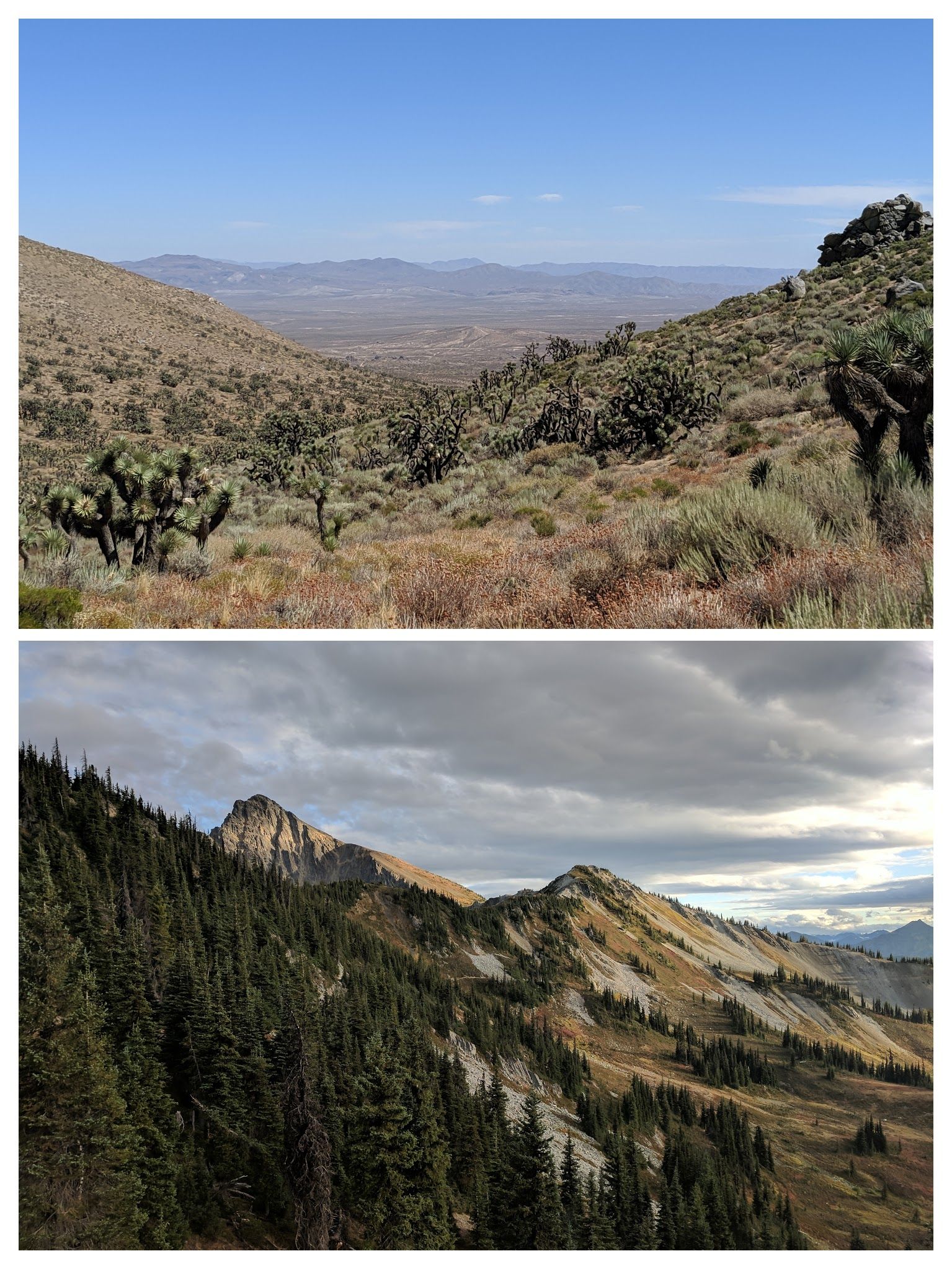27 things I learned hiking PCT SoBo vs NoBo

In 2017, I completed the section from Donner Pass to Manning Park going northbound on the Pacific Crest Trail. It was my first long distance hike and I learned what it takes to hike longer than a few days in the wilderness. I learned something worked or didn't but others seemed to take months to realize a better way to do it.
This year, I thought I had got it all sorted. After all, if my thru-hiking setup was good enough to get me to Canada, it should be good enough to get me to Mexico, right? However, the combination of different terrain, new innovations in equipment, and more experience as a hiker lead me to change a lot of things. I thought I'd share a few of the more important things with others in case it helps them too.
- Trailrunners instead of boots
When I went north in 2017, I did the entire hike in a single pair of Merril Moab 2 boots. While those had a great lifespan, they have a bad tendency to collect debris if you are not wearing gaiters. I used multiple trailrunners this time (La Sportiva Bushido and Altra Lone Peak 4s) and was impressed by how much support you get from an ultra lightweight a shoe. I occasionally miss the ankle protection and support but the pros of trailrunners outweighted the cons. - Make your own meals, bring your own spices
I relied a lot on freeze dried meals on my last hike. Not only do the same flavors get old, it can get expensive. This time I purchased my own freeze dried meat, my own dried veggies, and brought along several kinds of spices. Being able to be your own chef at the end of a long day on the trail was great. - Reuse meal containers to cook
I ended up taking one or two of the premade meals each section I did, if only to use the bag for cooking my own meals. The bags are very lightweight, great at heat retention, and it felt good to reuse something I would have trashed before. - Zero days are really important
I definitely learned this lesson northbound but only after pushing myself hard. I kept to my planned zero days from the beginning of going south and had little to no issues with pain or fatigue that I got sometimes going north. - Learn how to identify flora & fauna
You'll spend a lot of time out looking at all sorts of plants and animals when you're on the trail. Learning the names and how to identify the difference between species increased my appreciation of the nature around me. It's also a great way to pass time. - Easy access water
When I was heading north, I often just carried a bottle and my filter in my had as I hiked. This made things like using both trekking poles and taking a photo difficult. In order to have both of my hands free this time, I ended up jerry rigging a water sling to my pack and I can imagine doing a long hike without a similar set up in the future. - Use Gatorade bottles
I primarily used Smartwater bottles on my northbound trip. They offered a disposable but sturdy way to store water. This time I included reusing Gatorade bottles for their wide lip. Having a different kind of bottle makes like filling it up from a hose or from a low stream a lot easier. - Less trail magic SoBo
90%+ do the trail northbound so it should come as no surprise that you're pretty much on your own when you go southbound. I never expected or relied on the kindness of others on trail but it definitely makes the trip more enjoyable. - Cold soak
While I never took the full plunge and did nothing but, I started to utilize cold soak more going southbound. If I was low on gas during a long trip in the Sierra or didn't need a hot meal in the desert, I would simply prepare my dinner a couple of hours before stopping for the day. The meals turn out just as good, if not better. Just make sure that it is sealed up tight in your pack. - Extra batteries
Going northbound, I used a single backup battery to charge my phone. Many of the devices I use are USB rechargeable now so I carried a second. It felt good to not have to worry about running out of juice 4 days in to a 6 day section. - Bear canisters add a lot
Going north from Donner Pass, the only area that requires bear canisters is Lassen NP. Going south, the entire Sierras does. While an extra 2 pounds does not sound like much, the area it takes up in your pack does. - Embrace the times when you get no mobile service
Whether people like it or not, it seems like a lot of hikers become best friends with their phones on long thru-hikes. The High Sierra section of trail often has you sandwiched between two giant walls of granite. Putting the phone away and enjoying my surroundings made me appreciate the trail that much more. - Crocs are decent backup hiking shoes
I mostly use crocs as a camp shoe when I hike long distance. In the Sierras, I was often crossing streams that I needed to ford. After a day where I was getting close to a dozen crossings, I just left them on. I was surprised how well the foam shoe held up to rougher terrain. If my shoes started to bother me or my feet needed to breathe, I'd switch to the crocs for an hour or two. - Plenty of water in the Sierras
While I usually like to keep at least 4 L of water on my pack at any given time, most of the time between Yosemite and Mt. Whitney, I only needed 1 or 2 L of water. There are so many clear and full streams in the Sierras, there was no reason to carry more. - Hammock camping
For the first month or more, I exclusively used a hammock to camp. If there are any decent sized trees in the area, there is always a good place to hang. I even did it a few times between Joshua Trees in the the desert. Being up above the ground means you are never at the mercy of the angle of the terrain or if it is too rocky or wet. I find them to be much more comfortable than sleeping on the ground as well. - Stretching & Yoga
While hiking on the JMT, I came across someone who stretched before and after hiking for the day. I gave it a try and I was surprised at how effective it was. I felt like I had more energy and had less aches at the end of the day. I ended up settling into a routine of sun salutations I took from yoga. I'd recommend everyone give it a shot next time before a hike. - Wristwatch
Most people seem to just use their phone to tell time. Having a cheap digital wristwatch let me keep on top of my pace without having to distract myself with my phone or use its battery. - Take time to enjoy nature
I was obsessed with the amount of miles I had to do during a day when I was first starting out. Going south, I decided to linger on a little longer if I was sitting in a spot with a beautiful view or camped in a nice area. Having the flexibility to enjoy your surroundings made a big difference for how I appreciated the trail. - Don't pig out after
There is a natural tendency to want to pig out on food when you get back from a long hike. You've lost a lot of weight and your body wants it to go back. Easing yourself back into a normal diet helped me stay fit after coming back. - Asking for conditions
One of the nicest things about going south was all of the hikers going north that I could ask about the trail. Whether it be water, how long until a landmark, or what the snow was like, it was great to be able to ask. - Leave the contacts at home
I started wearing contacts earlier this year. However, with all of the dirt and all of the maintence, I switched back to my prescription sunglasses for most of the hike. - Split the PCT in two
I really enjoyed the way I ended up doing the PCT. I started at Donner Pass both times, which is roughly half way. It was easy for me to get to thanks to the large interstate right by the trailhead. It let me take my time to get my trail legs. It got me away from the crowds in Campo in the Spring. I didn't have to worry about taking 5 months off in a single time or worry about the snow in the Sierra. I'd like to do it all some day in one hike but starting at Donner Pass worked well for me. - Patagonia Baggies
I started wearing these shorts for hiking a few months before leaving on my sobo trip and I won't wear anything else for a long hike. They handle water and sweat like a champ. They are easy to clean and durable enough to sit on the hardest granite. I've found the shorter the better, so get the 5" inseam if you are having any question about it. - Replace worn out equipment frequently
I went to REI 3 times for my sobo hike. If something wasn't holding up as well (like a filter or shoes) and I didn't hesitate to replace it. You'll be thanking yourself when you get back out on the trail. - Hiker boxes
I only resupplied a few times by mail in Central and Southern California. The towns are farther apart and further off trail than the northern half of the PCT. Instead, I relied on stores and hiker boxes more. The stores often charge more but there is no shipping and it is worth it for the convenience alone. For hiker boxes, it's hard to beat free. - Keep notes
I installed Google Keep on my phone before leaving on my hike this time. A million things enter into your head when you are hiking alone so it was great to have a place to store that this time. - Get in-shape before starting
A lot of PCT hikers will tell you to just let the trail condition you. After a week or two, you get your trail legs and the hike seems to get a lot easier. While this worked for me going northbound, I was in much better shape this time when I started my southbound hike. It made the initial part of the hike much more enjoyable.
